History of the 81st P.V.I.
![]()
"The Fighting Chippewas"
By Robert Mischak, Ryan Lindbuchler, and Walter Boyle
Contents
Regiment Formation
Company K
Peninsula Campaign
Fair Oaks
Charles City Crossroads
South Mountain
Antietam
Fredericksburg
Chancellorsville
Gettysburg
Bristoe Station
Mine Run
Wilderness
Po River/Spotsylvania
Cold Harbor
Petersburg/Deep Bottom
Ream's Station
Farmville
Back to D.C.
Battles Fought
Original Aggregate
Total Losses (Regt.)
Total Losses (Co. K)
Organizational Commanders
Regimental Commanders
Company K Commanders
Hancock's Division
Officers Killed



Above: Colonels James Miller, Charles F. Johnson, and H. Boyd McKeen respectively. Photo credits: U.S. Military History Institute, Carlisle, Pa.
At this point we should discuss, in detail, the makeup of Company K, since it is the local men from this regiment that we are portraying, it would be in our best interest to learn as much as we can about the men we are mirroring. The source materials that we have show the name, highest rank attained, date mustered in, age at the time of muster, height, complexion, eye color, hair color, occupation, and residence at the time of muster. There is a problem however, because we have this information only about the men who enlisted between August and October of 1861. This information was not collected on the vast majority of the men who enlisted throughout the remainder of the war. After 1861, the company was supplemented by replacements in order to keep the regiment up to fighting strength. They received 7 recruits in late 1862, 3 in 1863, and 70 in 1864.
Of the 163 men who enlisted in Company K, we have residences listed for 84 of them. They breakdown in this manner:
|
Eckley |
38 |
|
|
Mauch Chunk |
15 |
|
|
Summit Hill |
3 |
|
|
Weatherly |
7 |
|
|
Drums |
3 |
|
|
White Haven |
6 |
|
|
Berwick |
2 |
|
|
Hazleton |
3 |
|
|
Monroe County |
1 |
|
|
Mifflinville |
1 |
|
|
Bristol |
1 |
|
|
Kunkletown |
1 |
|
|
Philadelphia |
4 |
|
|
Total |
84 |
|
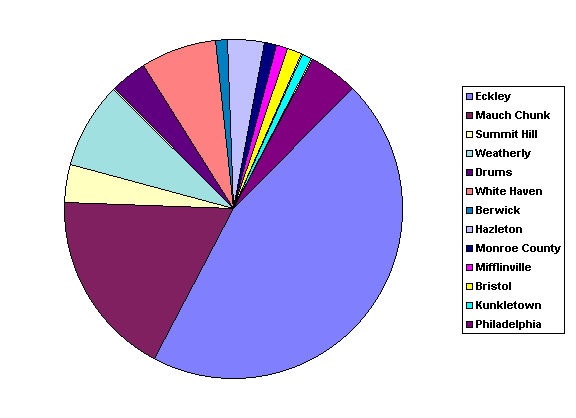


Above: Capt. Cyrus W. Straw and 1st Lt. Alonzo E. Bennett respectively. Notice Bennett's empty left coat sleeve; he lost his arm due to a wound received at Chancellorsville. Photo credits: U.S. Military History Institute, Carlisle, Pa.
The first Captain of Company K was Charles E. Foster, of Eckley, as was most of the Company. Captain Foster served until July 9, 1862, when he resigned. Next as the company commander was Capt. Cyrus W. Straw from 7/9/62 to 6/20/63 when he resigned due to a wound in the back suffered at Antietam. 1st Lieutenant Alonzo Bennet served from 7/13/63 until 10/12/63 when he was transferred to another regiment. Capt. James McKinley served from 10/12/63 to 6/4/65 when he resigned as the war ended. The last man to command the Company was 1st Lt. John Graham, from 6/16/65 to 6/29/65, when he was mustered out with the rest of the regiment. Total losses for the Company for the entire war are as follows:
|
|
Killed |
Wounded |
Prisoner |
Disease Deaths |
|
Officers |
1 |
5 |
0 |
0 |
|
Men |
20 |
60 |
8 |
11 |
|
Total |
21 |
65 |
8 |
11 |
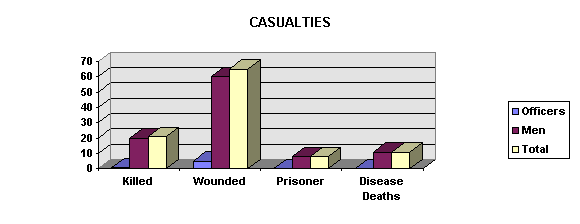
During the winter of 1861 the regiment was sent out on an expedition to Marlborough, Maryland, as a police force for preservation of order at a local election. After that detail, the regiment was sent out on picket expeditions under the command of Captain Thomas Harkness, of Company H, where men of the regiment saw action for the first time.
As part of the newly appointed General George B. McClellan’s plan to flank the Confederate capital at Richmond, the brigade the 81st was part of embarked from Alexandria, Va on April 4, 1862, for Fort Monroe, in the Chesapeake. The USS Spaulding transported the brigade, and also served as the headquarters of General Howard. Early on April 5th the brigade arrived at the fort and proceeded to Ship Point (about six miles southeast of Yorktown, Va.). It was during this time that Sgt. Sidney Hawk wrote home about the quality of the officers of the 81st. In the letter he states, "Our field officers are the best selected men in the Army of the Potomac. Colonel Miller is the right man in the right place and Lt. Col. Johnson is a gentleman and a soldier in every respect. Major Conner’s name is too well known for me to say anything about him - suffice to say that a better officer than Major Conner never buckled on a sword. Our company officers are very much respected and are worthy of the respect paid them".
During the following month the brigade built corduroy roads, besieged Yorktown, and marched through Williamsburg with the rest of the Army of the Potomac, and built two bridges, the most famous of the two being Sumner Bridge, across the Chickahominy River within eight miles of Richmond. These bridges helped provide the link between the army, now divided by the river.
After a brief skirmish at Golden’s Farm, the brigade was pulled back to the north side of the river at Fair Oaks Station. On the 30th of May, Confederate forces attacked Union forces in this area. The brigade was ordered forward but did not arrive until the 1st of June where the regiment took heavy casualties. The regiment was moved to fill in a gap between General William French’s brigade of the division and General David Birney’s division of the III Corps. During the Confederate general assault the regiment was shattered by two ruses. The 81st occupied the left of the brigade with its left flank exposed. A regiment of Confederates approached close upon the front, and Colonel Miller, supposing it to be a Union force, called out to it, and a volley was delivered from which he fell, shot through the head. This was the very same volley in which General Howard was shot in the arm and lost it as a result. Quickly thereafter, Confederate forces, waiving a bogus white flag, fired into the regiment’s left, causing it to lose contact with the right, which was now participating in the general retreat of the division. Finding that the right of the line had disappeared, Captain Harkness assumed command and led the battalion to the right where he was met by Lieutenant Nelson Miles, of General Howard’s staff, and ordered to retreat to the railroad. Files from Company H were detailed to take the body of Colonel Miller to the rear.
Regimental casualties for the battle of Fair Oaks were 91:
|
|
KILLED |
WOUNDED |
MISSING/CAPTURED |
|||
|
OFFICERS |
1 |
3 |
1 |
|||
|
MEN |
7 |
29 |
50 |
|||
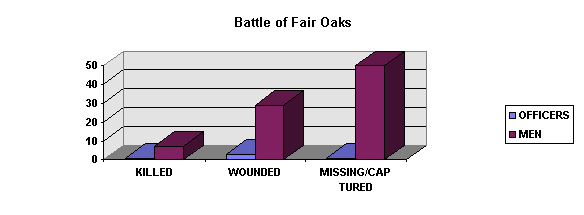
The loss among the officers was heavy as Colonel Miller was killed, Capt Robert M.Lee Jr. (Co.F), and 1st Lt. Horace M. Lee (Co.F) were mortally wounded. With the wounding of General Howard, James Caldwell succeeded to brigade command. Within the regiment, Lt. Col. Charles F. Johnson was promoted to Colonel, Maj. Eli T. Conner to Lt. Col., and adjutant H. Boyd McKeen to Major.
For the next month the brigade remained entrenched near Fair Oaks Station, during which time companies D, H, and K were serving on the picket line and withstood a Confederate assault even though the pickets to their right gave way and were pushed back. Captain Samuel Sherlock of Company D was killed as a result.
On the 29th of June the regiment was serving as a rear guard and held a position at Savage’s Station in support of artillery but was never engaged. The brigade then marched to White Oak Swamp where it was fired upon by Confederate artillery, with the 81st taking light casualties. The division was then hastened to Charles City Crossroads where there was furious night fighting from 6PM to 10PM, with the men’s volleys being directed at the muzzle flashes of the enemy. The regiment took heavy casualties with the wounding of the newly appointed Colonel Johnson, Captains William J. Conner, and Thomas Harkness, the latter receiving four wounds.

Above: Capt. Thomas C. Harkness. Photo cerdit: U.S. Military History Institute, Carlisle, Pa.
During the night the army retired to Malvern Hill where the division arrived there on July 1st. The brigade was sent forward at 3:00 PM to relieve Couch’s division of the IV Corps. According to Bates History of Pennsylvania Volunteers, "Here, while leading on his men, with great coolness and bravery, Lieutenant Colonel Conner was killed". Every assault of the enemy was bloodily repulsed, Lt. Colonel Conner being killed during the last Confederate assault. The losses of the regiment during the Seven Days’ Battles were severe at 175.
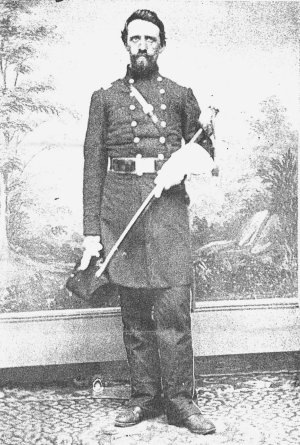
Above: Lt. Col. Eli T. Conner, killed at Carles City Crossroads. Photo credit: U.S. Military History Institute, Carlisle, Pa.
|
|
KILLED |
WOUNDED |
MISSING/CAPTURED |
|
OFFICERS |
2 |
10 |
0 |
|
MEN |
26 |
118 |
19 |
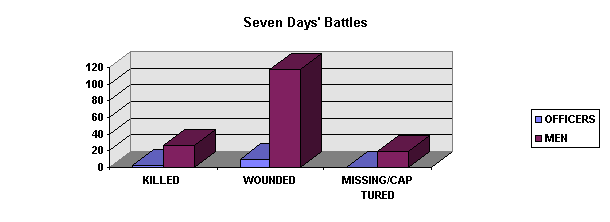
A list of those officers wounded include:
Col. Charles Johnson, 1st Lt. John W. Pryor (Co.G), 2nd Lt. Newton H. Beiber (Co.G),
Capt. Thomas Harkness (Co.H), Capt. William J. Conner (Co.I), 2nd Lt. Hewitt J. Abbott (Co.I), Maj. H.B. McKeen, Capt. William Wilson (Co.E), 1st Lt. Thomas C. Hawk (Co.I).
At midnight the brigade was withdrawn and proceeded toward Harrison’s Landing on the James River, some of the regiment’s pioneers clearing the wooded way with axes. with Colonel Johnson incapacitated by wounds and Lt. Col. Conner dead, Major McKeen was promoted to Lt. Col. and given command of the regiment. Capt. Robert M. Lee Jr. (Co F.) was promoted to Major.
It was during the Peninsula Campaign that the 81st first learned of the horror of combat and gave two of their best and bravest officers, Colonel James Miller and Lt. Colonel Eli Conner. Company K lost the following men:
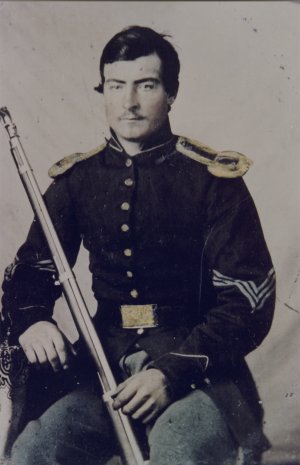
Sergeant John Williamson. Photo credit: Ms. Millys Altman
After General McClellan’s failure on the Peninsula, the Army of the Potomac began its return to Washington D.C. As part of the movement, the regiment took an interesting and typically Army like marching route. Being transported to Aquia Creek, Virginia, it was disembarked, marched to Falmouth, countermarched to Aquia, and re-embarked for Alexandria. At 11:00 AM on August 30, 1862, it was sent to the 2nd Bull Run battlefield but arrived too late to participate. It retired to Washington with General John Pope’s Army of Virginia, now defeated.
As the Army of the Potomac was again called upon to contest the Army of Northern Virginia’s movement north into Maryland, the brigade was bolstered by the addition of the 7th New York Volunteer Infantry.
As the extended armies intersected on September 14, to produce the battle of South Mountain, the division was held in reserve, but on the next day took the advance. With the support of the 8th Illinois Cavalry, the 81st single-handedly drove the enemy through Boonsboro and Keedysville to Antietam Creek where both armies gathered.
As the red sun dawned on September 17, it ushered in the single bloodiest day in American History. Fighting through the cornfield, Westwoods, and Dunker Church, the northern end of both armies had literally fought themselves into exhaustion. Around 9:00 AM, as the lull occurred on that part of the field, the II Corps crossed Antietam Creek at the ford a few miles east of Dunker Church, and the 1st division occupied the left of the Corps line opposite the now famous sunken road.
The Irish Brigade, to the right of Caldwell’s brigade (81st PVI, 5th NH, 7th NY, 61st NY, 64th NY), attacked first but was butchered by the withering Confederate fire from the sunken road. Thus, Caldwell’s brigade was thrown against the bolstered defenses of the sunken road. The movement by the brigade was made with such coolness and perfection, it appeared as a drill, though under fire. Then through much effort, the 81st and 5th NH took the higher ground to the left, and were able to deliver devastating enflade fire down the sunken road, causing many Confederate casualties and forcing a withdrawal. Moving past the road into an adjacent cornfield and orchard. the brigade was then stopped with heavy losses by newly arrived Confederate Artillery. Gallant attacks by small groups of the enemy created the illusion of a larger force, leading the brigade to pull back opposite the sunken road again, as the battle proceeded to its stalemate conclusion on all fronts.
Casualties were heavy for the battle of Antietam. Division commander, Gen Israel Richardson was mortally wounded, being temporarily replaced by Gen Caldwell of the brigade, and finally by Gen Winfield S. Hancock. Regimental losses, at 51, were less than many but severe enough for the already undersized regiment. General Caldwell later wrote that the 81st "fought with the utmost steadiness".
|
|
KILLED |
WOUNDED |
|
OFFICERS |
1 |
3 |
|
MEN |
6 |
41 |

After the battle of Antietam, the regiment moved to Harper’s Ferry, Va, and was sent on reconnaissance to Charles Town, Virginia without locating the enemy. The division then moved to Warrenton, Virginia.
When General Ambrose Burnside replaced General George McClellan as commander of the Army of the Potomac on November 11, 1862, he reorganized it into three "grand divisions". General Edwin Sumner was promoted to command of the Right Grand Division, which included the II Corps (now commanded by Gen. Darius Couch).
Also in November, Colonel Johnson resigned on account of wounds received at Charles City Crossroads, and Major M’Keen was promoted to Colonel, and Captain Robert M. Lee Jr., to Lt. Colonel. Subsequently, upon the resignation of Colonel Lee, on account of wounds received at Fair Oaks, Capt. Amos Stroh of Company G was promoted to Lt. Colonel, and Captain Thomas C. Harkness (Company H) to Major. One can see the high turnover rate of field and staff officers of a hard fought Infantry regiment of the Civil War. With regard to Company K, our beloved Capt. Charles Foster, of Eckley, resigned on July 9, 1862 and was succeeded by Capt. Cyrus W. Straw, also of Eckley. With regard to the brigade, the 145th PVI was added at this time.
On December 11, as pontoon bridges finally stretched across the Rappahannock, the regiment again supported artillery and, on December 12, crossed with most of the II Corps. It was then posted along the wharf where it rescued thirty boxes of tobacco the Confederates had tried to destroy in the river.
On the morning of the 13th, the regiment moved up Front Street to the railroad bridge, the right of the regiment near the grist mill. At 10 AM it went into action, moving down Sophia Street, under heavy artillery fire, taking casualties. It then participated in the ill-fated attack on Marye’s Heights south of the town, following Meagher’s Irish Brigade up and across the empty fields and moving thusly: 64 NYI, 61 NYI, 145 PVI, 7NYI, 81 PVI, and 5NHI. Heavily under close range musket fire and long range artillery fire, it relieved the decimated ranks of the preceding brigade as the survivors streamed back past the regiment.
The regiment proceeded even farther through the devastating fire, reaching farther than had any unit yet, until the intense fire and tremendous casualties forced it back to the line it had held until dark when it was ordered to be removed from the field. The brigade re-crossed the river with the rest of the shattered division on the 15th of December.
Of the five thousand men comprised in the division, two thousand fell in the charge. For the 81st, it was the most devastating battle of the entire war. Of about 19 officers, 12 were killed or wounded. According to Fox’s Regimental Losses In the Civil War, the regiment is ranked 12th out of the entire army for the most severe loss at that battle. Out of 261 men of the regiment engaged, 176 were casualties. This is a staggering loss of 67.4 percent. Lt. Clinton Swain of Company C was killed, Lt. Zadoc Aydelott of Company F was mortally wounded. Those wounded were: Colonel H. Boyd McKeen; Capt. William Willaimson, Co. E.; Major Thomas Harkness (for the second time); Capt. William J. Conner, Co. I; 1st Lt. John W. Pryor, Co. G; and 1st Lt. Jonathan Mc Laughlin, Co. H.

Above: Lt. Clinton Swain of Co. C, killed at Fredericksburg. Photo credit: U.S. Military History Institute, Carlisle, Pa.
|
|
KILLED |
WOUNDED |
MISSING |
|
OFFICERS |
1 |
11 |
0 |
|
MEN |
14 |
130 |
20 |
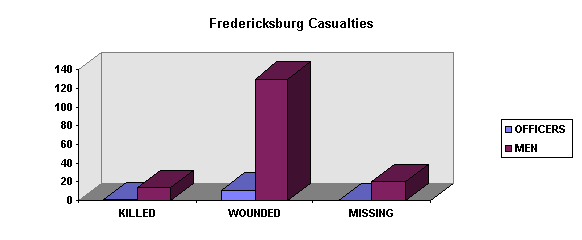
Due to the tremendous casualties, changes in command positions were in order. Capt. William Wilson (Co. E), though wounded, assumed regimental command in place of the more seriously wounded Col. McKeen and the incapacitated Lt. Col. Lee (suffering now like Col. Johnson, from old wounds): General John C. Caldwell was temporarily replaced by Col. George W. Von Schack as brigade commander; and the 148th PVI was added to the brigade, the sorry sight that it must have been ( the 81st numbering a whopping 85 men on December 15th).
After convalescing at Falmouth for a month, the army was again put in motion on January 21-22, 1863, in General Burnside’s futile attempt to turn the left flank of the Army of Northern Virginia. Fortunately for the II Corps, they were to make a faint attack at Fredericksburg and escaped the horrors of the flank march through Virginia mud created by winter rain. This "mud march" not only put an end to the winter campaign, but also General Burnside’s career as commander of the Army of the Potomac.
Company K lost three men at this battle along with the rest of the regiment. It’s losses at the battle of Fredericksburg were: Cpl. Charles W. Fellows, killed; Pvt. Joseph Matthews, killed; and Pvt. Daniel Washburn, wounded. The company also lost Pvt. John Andreas, who died of disease at Falmouth, Va in December of 62. This is quite considerable when you realize that by this time the company was no larger than 25 men, or 1/4 their desired strength.
|
|
81st as of 12/12/62 |
81st as of 12/14/62 |
|
Regimental Strength |
261 |
85 |
|
|
|
|
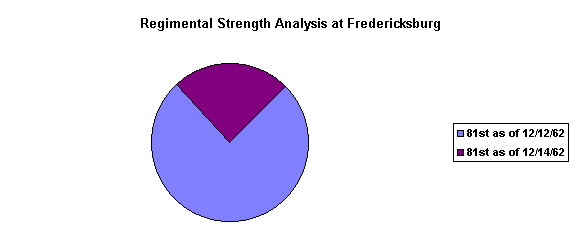
On January 25, 1863, General Joseph Hooker relieved General Ambrose E. Burnside of command of the Army of the Potomac under orders from President Lincoln in an attempt to find an effective commander to lead Union forces in the east. The new commander made definite changes in the army, such as placing greater emphasis on the cavalry as a fighting arm and ending the "grand division" system of Burnside in favor of the older, simpler corps set-up. This would have returned General Edwin Sumner to command of the II Corps, except that he was reassigned to command the Department of Missouri, dying on his way there on March 21. General Darius Couch, therefore, remained in command of the corps.
There were also changes on the brigade and regimental level. General John C. Caldwell, wounded at Fredericksburg, returned as commander of the brigade, which was reduced to the 5th NHVI, 61st NYVI, 81st PVI, and 148th PVI. On April 17, the regiment’s Lt. Colonel Lee was discharged due to a nagging injury suffered at Fair Oaks in 1862. Capt. Amos Stroh (Co.G) was promoted to Lt. Colonel of the regiment; Capt. Thomas C. Harkness (Co. H) was promoted to Major.
The commanding general, knowing the government’s desire for victory, came up with a plan. Ironically, it was the same plan that was envisioned by Gen. Burnside (his ending with the failure known as the "Mud March"). However, this time the army would not be bedeviled by intemperate weather and together with Hooker’s insistence on the secrecy of the movement (only he knew where the army was going) seemed a sure formula for victory. Such was not the case.
While the VI Corps was to push toward Marye’s Heights at Fredericksburg, the rest of the army was to swing around the Confederate left. As part of the latter movement, the division crossed the pontoon bridges at United States Ford on the Rapidan River on April 30. While the 5th NHVI, 81st PVI, and the 88th NYVI (Irish Brigade) acted as rear guard for the II Corps ammunition train until it crossed, the rest of the division continued on toward Chancellorsville, encamping 1/2 mile west of the crossroads in the Wilderness at 10:00 PM.
As the new month arrived, the division saw action. Moved to the front and slightly engaging the enemy, it held a position with the V Corps near the Chancellor Mansion, where it was joined by the rearguard from the ford. On May 2, as the rest of the Union Army formed its semi-circular position and General Stonewall Jackson was making his flank march, the brigade (with other regiments) formed thusly: 5th NHVI, 81st PVI, 88NYVI, 64th NYVI, 148th PVI, and 61st NYVI. but was not engaged (Jackson’s attack stalling before reaching it).
Stonewall was wounded by his own men, Hooker was knocked unconscious by a collision of cannonball and mansion pillar, and the battle went from ambiguity to a boring but deadly statement, both at Chancellorsville and to the east (the VI Corps having pushed through Marye’s Heights but little else) despite the Union possessing a better than 2 to 1 advantage in men. Finally, "Fighting Joe" led the army (scratching its collective head) back to the camp at Falmouth on May 5, leaving Gen. Robert E. Lee with the field and a strange and unexpected victory. Abraham Lincoln was heard nervously pacing the White House shrieking, "My God! My God! What will the country say?? What will the country say??". Regimental losses on May 1 were considerable at 61, with Colonel McKeen and Major Harkness (for the third time) wounded.
|
|
KILLED |
WOUNDED |
MISSING |
|
OFFICERS |
0 |
4 |
0 |
|
MEN |
4 |
34 |
19 |

Company K had one loss; Pvt. Frederick Bloom. He is listed on the roster as having been a Coal Miner from Eckley, 34yrs of age, 5’8", blue eyes, brown hair, with a fair complexion. He was mortally wounded on May 1, 1863 and died shortly thereafter.
Everyone was in distress. General Hooker had wasted an excellent opportunity for the ultimate victory at Chancellorsville. General Darius Couch, commander of the II Corps, was so upset that he requested a reassignment. Hooker himself went around brooding and asking to be relieved. Lincoln told him to go after the Army of Northern Virginia which was now marching north toward Pennsylvania.
Stronger than it had ever been since the spring of 1862, the army of General Lee, full of hope, had begun its second attempt to invade the North. A chance to obtain needed supplies, disrupt the North’s serenity, defeat a depleted Union Army (the 81st was down to approximately 200 men with Company F down to 6!) on northern soil, and possibly change the political climate of Europe led the rebel army northward.
General Couch reluctantly had his request for transfer honored by being reassigned to the Department of the Susquehanna in Harrisburg--right where Lee was headed. This allowed General Hancock to move up to command the II Corps, General Caldwell to command the division, and Colonel Edward Cross (5th NHVI) to brigade command.
As the armies snaked toward their destiny in Pennsylvania, the regiment, which was for the most part barefoot, followed the serpentine route north. On June 6, a detachment of the regiment under Colonel McKeen was sent to support the cavalry across the Rappahannock River. On June 18, the rest of the regiment moved to Stafford Court House (about 10 miles northeast of Fredericksburg). It then continued to follow its along-the-Potomac route through Dumfries to Sangster’s Station (20 miles southwest of Washington) where it was joined by the detachment of Col. McKeen. It then marched directly west through Thoroughfare Gap where it spent four days on picket duty. By June 28, it had reached the Baltimore and Ohio Railroad crossing on the Monocacy River (about 5 miles south of Frederick Maryland) and stood night guard duty with a section of artillery. The following day, it continued on to Uniontown Maryland (about 10 miles southeast of Taneytown).
At this time, on the eve of battle, the last Hooker request to be relieved was accepted, General George G. Meade replacing him.
As segments of each army converged on July 1 and locked together in the inferno of Gettysburg, the Corps was ordered north to the town, passing the cavalry escort bearing the body of General John Reynolds, and arrived at night. It was posted two miles below the town and built breastworks.
On July 2, the regiment occupied the left center of the line on Cemetery Ridge (where a small marker today indicates the position of the 81st) when it was called into action. As the fighting broke out at the southern end of the line at 4:00 PM, the division was ordered to that area. Here the brigade was deployed by the left flank east of the wheatfield. The colorbearer, a 20 year old Philadelphia seaman named James "Reddy" McHale of Company B, did not know it when the regiment was deployed, but it was to be his last battle. McHale had taken up the banner at the battle of Fredericksburg when Color-Sergeant John B. Munyan of Company A was wounded three times. McHale took the colors from Munyan, stopping to rescue the fallen banner of another regiment as he retreated with the rest of the regiment.
The regiment was deployed behind a stone wall in the following order, as depicted today by the placement of the regimental monuments: 61st NYVI, 81st PVI, 148th PVI, and 5th NHVI. Preparing for the division’s general advance, only part of the brigade (61st NY, 81st PA, and a segment of the 148th PA) was ordered forward in the general advance, forming the left of the division’s line. It engaged the enemy (Longstreet’s Corps) and drove it 400 yards and took prisoners. It was at the time of the initial onslaught that color bearer McHale surged forward in advance, urging the men on. He fell shot through the heart almost instantly. McHale had carried the colors ever since Fredericksburg, but because of his unkempt personal appearance, was deprived of carrying the flag at formal reviews. His nickname "Reddy" came from his "uncombed, uncut, shaggy red hair" This "careless waif"was much loved by his comrades.
When a renewed Confederate advance drove back the right side of the line and threatened the brigade, General Caldwell threw in Colonel John Brooke’s brigade of the division (serving in reserve) and a brigade of General Romeyn Ayres’ division (V Corps), the latter relieving the brigade. Colonel Cross having now been killed, Colonel McKeen took over brigade command, had the 61st NYVI and 81st PVI retire to the stone wall, but left the 148th PVI behind to cover the relieving columns left. This segment was soon relieved by another brigade of Ayres’ division and joined the rest of the brigade behind the stone wall.
Having stopped and reversed the Confederate counterattacks, these reinforcements were in turn forced to retire, leaving the wheatfield in enemy hands. At 9:00 PM the division was returned to its original position on Cemetery Ridge, now missing half of the men that left the position earlier that day.
The fury of Pickett’s Charge was the dominating factor on July 3 though the regiment had only a small taste of it. The morning of the third day was spent building breastworks which served as some protection during the afternoon artillery duel. Later the charge just missed the division, going north of it, except for one Florida brigade which was broken by cannon fire before it came into musket range. Many of these then ran toward the brigade’s lines as voluntary prisoners!
The smoke of three days of battle finally cleared, revealing 62 regimental casualties:
|
|
KILLED |
WOUNDED |
MISSING |
|
OFFICERS |
0 |
5 |
0 |
|
MEN |
5 |
44 |
8 |
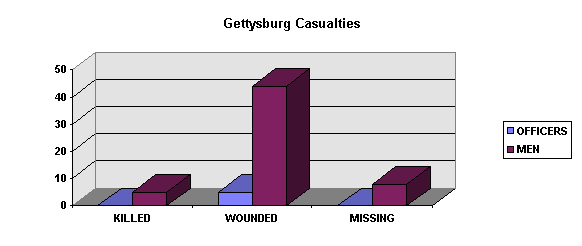
Changes in command also occurred. General Hancock, wounded on July 2, was replaced as Corps commander by General William Hays. Colonel Cross, the brigade commander, having been killed, was eventually replaced by Colonel Nelson Miles.
The regiment lost Capt. John Pryor (Co. D), and 2nd Lt. John Patton (Co. G), wounded. Company K lost Pvt. Henry Shafer who was killed. He is listed on the roster as having been a miner from Eckley, being 23 at his enlistment in Oct. of 1861, 5’5", fair complexion, blue eyes, and light hair. It is believed that he is interred in the National Cemetery at Gettysburg.
|
|
81st as of 7/1/63 |
81st as of 7/4/63 |
|
Regimental Strength |
200 |
138 |
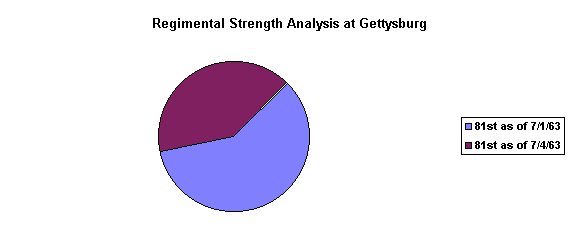
After the battle, the Corps was involved in the half-hearted pursuit of the retreating enemy. On July10, the brigade, supporting the third division, drove the enemy near Hagerstown, Maryland. On July 14, the brigade captured 50 prisoners, then proceeded with the division to Maryland Heights at Harper’s Ferry. Finally on July 18, the division returned to Hagerstown, where regimental Lt. Col. Stroh resigned on July 22. Later, on July24, Maj. Harkness was commissioned Lt. Colonel.
General Lee and his badly battered Army of Northern Virginia had survived its greatest defeat and escaped. But it would never be the same. Never would it be as powerful, never would it again invade the North, never would there be any more grand charges. Offensive strategies were now a thing of the past. Two years of war lay ahead, but it would be another kind. It was the end of an era.
As the summer of 1863 wore on, both armies assumed the general position held the previous winter with the Rappahannock River of Virginia between them. Summer’s end, followed by fall and winter, was a time of only minor operations and relative inactivity on the battlefield.
At this time, several organizational changes occurred. The recuperating General Hancock had his position semi-permanently taken by General Gouvenor K Warren (whose position was, in turn, filled several times during the fall and winter by General Caldwell). The brigade was reorganized by having the 148th PVI transferred to the third brigade, the 5th NHVI sent to Maryland on prison guard duty (later to return), and the 140th PVI added.
In October, an attempt by General Lee to strike at General Meade’s supply line caused the latter to retreat on Centreville. This movement isolated the II Corps, creating an opportunity for Lee. The resulting action on October 14 involved some skirmishing near Auburn (where the regiment supported Capt Robert Bruce Rickett’s Battery F of the 1st Pa Light Artillery) and, later that day, a larger engagement near Bristoe Station ( 5 miles southeast of Mannassas Junction). The strategic position held by the corps (in which the 61st NYVI and the 81st PVI were sent to extend the right side of the second division’s line) allowed them to repel the Confederate attack and then escape under the cover of darkness.
Regimental casualties for the battle of Bristoe Station were 5 enlisted men wounded.
General Lee, feeling his army too far extended, returned south of the Rappahannock, bringing in the month of November. In that month, the 26th Michigan Infantry was added to the brigade (which was now back to four regiments). As the month’s end loomed, General Lee scattered his troops for winter quarters, with his II Corps (Gen. Ewell’s) near Mine Run (12 miles west of Chancellorsville). Trying to do another Burnside on the Confederates (last chance before winter and all), Meade planned to march on and destroy Ewell’s isolated Corps and disrupt the Army of Northern Virginia. Inevitable delays, however, disrupted Meade’s offensive rather than the enemy, and though skirmishing on November 29 drove back advanced Confederate units, the arrival of heavy southern reinforcements caused the attempt to be called off on November 30. Regimental casualties for the Battle of Mine Run were 7. One officer (Capt. David Phillips, Co. I) was killed, and six enlisted men were wounded, none from Company K.
On December 1, the brigade crossed the Rapidan River at Culpeper Mine Ford to winter quarters at Mountain Run (north of Stevensburg).
In January, several events affecting the regiment took place. Although their terms of enlistment would not expire until the summer, a sufficient number of veterans reenlisted (and received veteran furloughs) to insure the continuance of the 81st as a regiment. Also, Company K received 70 recruits to replenish it’s thin ranks, along with the rest of the regiment. Colonel McKeen assumed temporary command of the brigade for the absent Colonel Nelson Miles, while Capt. William Wilson (Co. E) assumed regimental command in place of the indisposed Lt. Colonel Harkness.
The next month, the brigade (under Colonel McKeen) was involved in the Corp’s demonstration at Morton’s Ford on the Rapidan (5 miles south Stevensburg). Having reached the ford about noon on February 6, the third division was sent across and met a force of Confederates. Remaining with the rest of the corps on the river’s northern side, the regiment (under Lt. Col. Broady of the 61st NYVI) was ordered to the left of the division’s line to skirmish across the river but encountered no enemy. The next day, while the brigade supported a section of Rickett’s Battery, the enemy’s attempt to drive a wedge between the third division and the river forced that division’s recrossing. After dark, the corps returned to camp.
The following two months were consumed by reorganization. On March 2, Capt. Wilson (acting commander of the regiment) was promoted to Major. On April 22nd, 1st Lt. James McKinley was promoted to command of Company K. On March 9, after having already been brought east, Ulysses S. Grant was commissioned Lieutenant General (the first since George Washington) and given command of all Union armies. On March 14, Lt. Colonel Harkness resigned. On March 25, General Caldwell was relieved of division command to receive a seat on a special military commission in the capital. His replacement was General Francis Barlow (reassigned from the Department of the South). By month’s end, Colonel Miles was back in brigade command, and the 183rd P.V.I. was added to his unit, augmenting it to five regiments: 26th MVI, 61st NYVI, 81st PVI, 140th PVI, and the 183rd PVI. On April 22, Major Wilson was again promoted, this time to Lt. Colonel of the regiment.
In the works before General Grant arrived, a final consolidation of corps took place in the Army of the Potomac. With the XI and XII Corps having been sent west (to stay) in November, this army’s remaining five corps were merged into three: the II Corps (commanded by the now healthy General Hancock), the V Corps (General Warren from the II Corps), and the VI Corps (General John Sedgewick). Even the old cavalry commanders were gone, General Philip Sheridan now running that corps.
Change was in the air as the boys of the 81st shined their brass in preparation for the new spring campaign. Little did they know they would soon go through the bloodiest 30 days of the war.
The campaign of glory had its auspicious start near midnight on May 3, 1864. Camp near Stevensburg, Virginia, having been broken, the Army of the Potomac moved through the darkness, crossed the Rapidan at Germanna Ford (V and VI Corps) and Ely Ford (II Corps), and plunged into more darkness in the center of the tangled growth, encamped.
General Lee decided it would be to his advantage to strike the Union army while it was still in a more open setting. So, on May 5, as the Army of the Potomac was moving out of the Wilderness, the Confederates struck along two parallel east-west roads. The II Corps, which was leading the Union march and leaving the Wilderness, had to be recalled.
The collision of armies was fierce (with the II Corps deployed at the junction of the Brock and Orange Plank Roads) and did not abate as more and more men reaching the front were sucked into the contest. As the shadows continued fighting into evening, the battle of Chancellorsville (fought in the vicinity) was remembered, and soldiers claimed to see comrades, killed at Chancellorsville but now alive again, fighting silently alongside them in the haunted woodland. As midnight approached, the lines, which had shifted a bit during the day, assumed their original positions.
On May 6, beckoning the fighting to resume before dawn, the twisted darkness began toying with the armies. Strange things occurred. Half the Corps drove the enemy for a mile and stood 100 yards from breaking the Confederate lines at the Tapp farm, when a battalion of artillery held off the 20,000 plus men. Then as General Longstreet’s reinforcements appeared, the corps suddenly found itself back where it had started. Longstreet himself was wounded by Confederate rifles (an event a little too similar to what had happened there a year before to Gen. Jackson). The IX Corps of General Burnside, used ostensibly as reserve and rear guard, was brought into the fray to shift the balance: it moved into the woods and promptly vanished. Men, marching to the rear, ended up in enemy lines. Fires broke out and 200 men burned to death. When temporal night (it was always night in the Wilderness) finally put an end to this, casualties of nearly 30,000 (both sides combined) were sustained in the two-day battle.
The regiment, sent to the extreme left of the line on the second day, escaped the battle with no casualties reported.
Both commanders, shaken by what had occurred, moved their armies to a point south, hoping to outflank each other. The Union force, held up by cluttered roads, arrived last. The place......Spotsylvania Court House. On the way, the brigade had a brush with the enemy at the Po River on May 10.
Among the last to reach the Spotsylvania battlefield, the division went into action on May 12 on the left of the corps as it assailed the famous salient in the Confederate lines. As the corps crushed the extended enemy position, the brigade took their objective with the bayonet, capturing men and artillery. It was during this bayonet charge that Private Thomas Robinson of Company H captured an undesignated Confederate flag and subsequently received the Congressional Medal of Honor for his heroism. Confederate resistance finally stiffened and drove the Union troops back. The VI Corps and part of the V Corps were thrown in as fighting continued hand to hand in the rain, hour after hour, until the bodies were nine deep in some places and many disappeared in the mud during the intense, trampling confusion. Only the arrival of midnight put an end to this sorry situation, as the Confederates withdrew to an interior line.
Combined casualties were, again, tremendous at 15, 000. Regimental losses for the battle of Spotsylvania and the Po River were a substantial 77.
|
|
KILLED |
WOUNDED |
MISSING |
|
OFFICERS |
1 |
2 |
0 |
|
MEN |
9 |
61 |
4 |
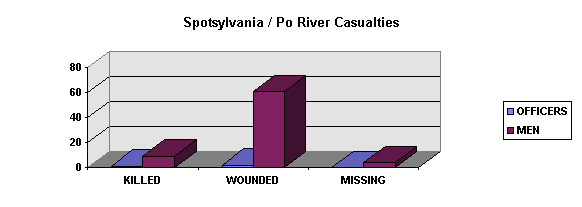
Among the killed was 2nd Lt. Sidney Hawk of Company I. Among the wounded were Lt. Colonel William Wilson and Capt. Thomas Williams of Company H. Of Company K, Pvt. Penrose Lowers was killed. Lowers was from Mauch Chunk and had enlisted that March with a few other men. Also, Private Paul Zollinger was also killed. Zollinger enlisted with Lowers in March and was killed during the bayonet charge on the salient.
General Grant’s statement that he was willing to "fight it out on this line (Spotsylvania) if it takes all summer" seemed to be verifiable as the commander continued to maneuver to gain an advantage. As part of this, the brigade was moved to the extreme left of the Union lines as reserve for the IX Corps and supported an unsuccessful charge on the enemy’s works there.
On May 21, Grant had had enough, the Spotsylvania situation provided no potential, and that night the army moved SOUTH. Lee also hurried south, reaching the North Anna River in time to put up a feeble opposition to the II and V Corps as they forced their way across on May 24. Lee, undaunted, then placed his army between the two corps and fought off all their attempts to unite. Grant, realizing the peril of the separated columns, had the two recross the river on May 26.
Swinging south again with the army. the brigade crossed the Pamunkey River at Hanovertown on May 28, after which the regiment, along with others, supported the cavalry fight at Haw’s Shop (10 miles northeast of Richmond).
On May 29, the corps marched to the junction of the Cold Harbor and Court House roads, met the enemy, and pushed them to Totopotomy Creek. Here the 2nd NY Heavy Artillery was added to the brigade. Regimental casualties for the battle of the North Anna and action along the Pamunkey River and Totopotomy Creek were 2: 1 man killed, and I man wounded, none from Company K.
In June, both armies converged at Cold Harbor. On the first day of the month, each army consolidated, and the Confederates were forced back to a secondary line of fortifications. On this date, the 5th New Hampshire Infantry was re-added to the brigade after acting as prisoner guards for a few months. At this juncture of operations, any swinging movement on the Union’s part would have led Lee simply to retire within the Richmond fortifications. To avoid a prolonged siege under those circumstances, Grant decided on a frontal attack with June 2 being used for preparation (the II Corps forming the Union left). On June 3, in a rainy dawn, the II, VI, and XVIII Corps charged to their doom. Forced to cross broken ground, the individual units became disconnected as they faced a solid wall of fire. Their courage allowed some to reach the enemy’s works, only to be driven back again. The division and the regiment was particularly hard hit. Before an hour or less elapsed, the attack’s hopelessness was realized, and demonstrations by the V and IX Corps on the right were called off. Combined casualties for that hour were a staggering 10,000 (fully two-thirds of them Union). Among them was the mortal wounding of the beloved Colonel McKeen, who had served the longest as the regimental commander of the 81st and was its most popular and respected commander. He had recently been promoted to brigade command of the first brigade of the second division and died at the head of those men as he led them in the assault. Many of his superiors respected him as an extraordinary officer and commented on him:
"His bravery and coolness were conspicuous."
--General John C. Caldwell,
commanding the brigade,
writing on 9/24/62 of Antietam.
"He behaved with extraordinary gallantry."
--Gen. Winfield Hancock,
commanding the division,
writing on
12/25/62 of Fredericksburg.
"After the fall of Colonel Cross, he succeeded to the command of the first brigade, behaved, as he always has on every battlefield, with the most distinguished gallantry, and brought off his command in perfect order."
--Gen. John C. Caldwell,
comanding the division,
writing on
9/5/63 of Gettysburg.
"He was one of the best known and most deserving officers of this corps."
--Gen. Winfield Hancock,
commanding the corps,
writing on 9/64.
"He was an officer of great ability and distinction, both in camp and on the field, a gentleman of high-toned character, who had served in this brigade since its organization and participated in every engagement."
-Gen. Nelson Miles,
commanding the brigade,
writing on 10/30/64.
"He was a most promising young officer, who had never failed to distinguish himself in battle."
--Gen. Winfield Hancock,
commanding the Middle Military District,
writing on 9/21/65.
The armies remained entrenched for ten days, a time marked by sharpshooting and infrequent, minor, and unsuccessful charges, creating a deadly no-man’s land between the lines.
Regimental casualties for the futile Battle of Cold Harbor and the succeeding week were 44:
|
|
KILLED |
WOUNDED |
MISSING |
|
OFFICERS |
1 |
0 |
0 |
|
MEN |
7 |
33 |
3 |

Company K lost many comrades in this engagement. Corporal Michael Carroll was mortally wounded and is currently interred at Arlington National Cemetery. He was from Hazleton, enlisted in October of 1861 with the original company, was 22 years of age, was 5’8" and a laborer by occupation. Private Edward Buminghoff was declared Missing in Action and was never heard from again. He enlisted in March of 1864 and was from Luzerne County. Private John Deal was also killed and was another man enlisted in 1864. He is also interred at Arlington National Cemetery. Pvt. Isaac Kenvin was wounded but lived. Private William Morgan was mortally wounded in the engagement and died from his wounds on July 26th. He was a laborer from Eckley and was also one of the original members of the company when it was mustered. He was 27, 5’3", and had green eyes.
As can be plainly seen, Company K had its greatest loss of the entire war at Cold Harbor.
The spring campaign had already netted 87,000 casualties (55,000 Union and 32,000 Confederate) with what seemed to be no strategic advantage for the Federal side. Grant was being called "The Butcher" by the northern conscience. Many questioned the government’s choice of commander, questioned the president’s competency. Grant was turning the conflict into a war of attrition. Lincoln understood. Many didn’t. Many still don’t.
As part of Grant’s attempt to control the strategic but lightly defended railroad center of Peters burg, south of Richmond, the II Corps, along with the regiment, arrived near the city on June 14. Unwarranted delays and half-hearted advances ended any hope of an easy capture. Confederate reinforcements soon filled the city, and the major Union assault on June 17 was unsuccessful. Regimental casualties for this battle of Petersburg were 25, including Captain David H. Ginder of Company I, killed in action.
Grant’s failure resulted in siege operations against the city (and, to a lesser degree, Richmond) and essentially trench warfare that would last out the rest of the war. Interspersed in this type of strategy were to be various operations meant to capture important positions and extend Union lines (i.e. thin out the Confederate lines) about the city.
The first of these operations was the attempt of the II and VI Corps to cut the Weldon Railroad south of Petersburg on June 21-23. In this maneuver, the two corps became separated and were bloodily repulsed. The regiment, however, suffered no casualties.
It had been a horrible campaign since the spring. The blood-soaked trail had led both armies essentially back to the positions held in the spring of 1862. Grant’s ceaseless driving of the army had produced its disastrous results. The men remarked how the best officers and men (the old veterans) were all gone. Morale was at a low ebb, noted in the VI Corps reticence in burnishing their rifle barrels and the II Corps’ apathetic charges.
On top of all this, a presidential election loomed in the fall. The Peace Party had been making political capital this spring on all the bad news from the front. Many questioned Lincoln’s chances of success at the polls. Even the president himself was uneasy, promising if not reelected, to resign in favor of his opponent. Grant felt the pressure and a much more militarily restrained July would follow. By the end of June, as the siege situation solidified, various lower level organizational changes occurred. Brigade commander Colonel Miles was promoted to General. The 28th Mass Infantry was added to the brigade, which now consisted of 5NH, 26MI, 28MA, 61NY, 81PA, 140PA, 183PA, and 2NY Heavy Artillery. Lt. Colonel Wilson returned from convalescence to command the regiment.
The failure of the attack at the Crater at the end of July was the introduction to the resumption of a more heated conflict. Lee, after his Crater success, felt able to begin dispatching reinforcements to General Jubal Early operating in the Shenandoah Valley. This action depleted the Confederate lines near Richmond and spurred Grant to plan an attack there. For his operation, the II and X Corps (from the Army of the James), were chosen. Leaving City Point (the Union supply base 12 miles from Richmond), the two corps with General David Gregg’s cavalry division crossed the James River on August 13 and reached the enemy’s lines at Deep Bottom (10 miles southeast of Richmond) the next day. As Lee was forced to bolster this line, ineffectual fighting resulted and continued to result for the next four days as Confederate weak spots were sought. During this period, the regiment mostly marched, built breastworks, and reconnoitered with and supported cavalry. Their only real enemy encounter was in an area known as Strawberry Plains on August 16. Thus, the combined regimental casualties for the first Petersburg battle and Deep Bottom were 36.
|
|
KILLED |
WOUNDED |
MISSING |
|
OFFICERS |
1 |
2 |
0 |
|
MEN |
6 |
22 |
5 |

Among the wounded at Deep Bottom was Captain James P. Quinlan, of company E. Company K lost Private Edward Steinbeck at Petersburg because he was wounded. On August 17, division commander General Barlow became ill, allowing General Miles to replace him and Colonel James Lynch (183rd PA) to replace Miles in brigade command.
Though the Deep Bottom action was turning into a failure in regard to its planned goal, it did succeed in causing Lee, first, to retain several divisions that were to reach Early in the Valley and, second, to bring in reinforcements from the line south of Petersburg. The latter of these allowed Grant again to move against the Weldon Railroad.
While the two corps were still at Deep Bottom, the V Corps was sent into what resulted in a fierce three-day battle of ebb and flow concluding on August 21 in the V Corps capturing and holding a piece of the railroad four miles south of Petersburg.
At this time, part of the II Corps (including the regiment) was withdrawn across the James to help in the destruction of the railroad south of the V Corps’ position. The wrecking work continued for four miles to Ream’s Station, where breastworks were built for a base. Here Colonel Lynch was relieved from brigade command in order to command the occupation of the station with the 81st PA. and the 183rd PA. On August 24, this segment of the brigade was relieved at the station by part of the second division, and Lynch resumed command of the brigade, which continued its railroad destruction for several more miles.
On August 25, it came to blows. Having now destroyed about eight miles of track, the corps encountered an enemy force on that morning. General Hancock ordered the corps back to Ream’s Station, beat off the Confederate attacks until nightfall, and then retreated to the V Corps’ position. Regimental casualties for the Battle of Ream’s Station were 40:
|
|
KILLED |
WOUNDED |
MISSING |
|
OFFICERS |
2 |
2 |
0 |
|
MEN |
3 |
6 |
27 |

Among the killed was 2nd Lieutenant Peter McGee of Company A, and 2nd Lieutenant Emanual Hoover of Company K. Among the wounded was Captain James H. Mitchell of Company D. As can be plainly seen, the bulk of casualties were in the missing/captured category. This is because the brigade was in a fighting withdrawal and many men were lost or captured in the confusion of the fight. Lieutenant Hoover was sorely missed by the men of Company K because he had always been there for his comrades since the company was mustered in. He enlisted in October of 1861 as a sergeant, was from Eckley, was 5’7", had blue eyes and sandy colored hair, and was a shoemaker by trade.
Several organizational events occurred at the end of August. On August 29, regimental commander Lt. Colonel Wilson was assigned to command the division’s "consolidated brigade" (composed of the former second and third brigades), while Capt. Lawrence Mercer (Company A) resumed regimental command. The 4th NY Heavy Artillery was also added to the brigade.
The fury of August had spent itself, the Weldon Railroad was cut, the Union forces could relax. September passed uneventfully for the Army of the Potomac. The regiment’s Company K, however, received about 40 new members recruited during the past two months.
As the new month was entered, Lt. Col. Wilson returned to command the brigade on October 6. On October 13, under a suggestion from General Miles, several of the brigade’s regiments were to be transferred to new positions in the lines for reasons of numbers of men, less chance of large amounts of new recruits bolting, and the ease of drill. Included among these was the 81st, sent to Battery No. 4 in place of the 2nd NY Heavy Artillery. The brigade was then occupied with tearing down the old works of Fort Steadman that obstructed the field of fire. On October 27, the corps participated in the attempt to turn the Confederate right at Hatcher’s Run and cut the Southside Railroad west of Petersburg. This maneuver involving three corps became uncoordinated, fighting was ineffectual (the regiment suffered no reported casualties), and the corps returned to the original lines. Finally, on October 30, Lt. Col. Wilson was promoted to Colonel and regimental commander Capt. Mercer to Major.
November saw more organizational moves. On November 1, the brigade was relieved from tearing Ft. Steadman’s old works by the second division and moved to the rear to build winter quarters. Two days later, Col. Wilson was relieved of brigade command and returned to the regiment. On November 5, General Barlow, because of his continued illness, received a leave of absence until April 1, 1865. The empty position of brigade commander was filled by General George Macy (who had also previously replaced Col. Wilson in "consolidated brigade" command) on November 7. The next day, the 28th Mass was transferred to the reconstituted second brigade.
It was also a political month. Though Lincoln’s prospects for reelection were still in doubt, his chances had improved since the summer. This was due particularly to the army’s support and the battlefield successes of General Sherman at Atlanta and General Sheridan in the Shenandoah Valley. The November 8 election nationwide proved a landslide for the president, but the results within the regiment are interesting: 23 for Lincoln, 44 for McClellan.
A major event affecting the corps also occurred in November. Seventeen days after the election, General Hancock, still bothered by the wound received at Gettysburg, was granted a 20 day leave, being replaced by Chief-of-Staff Gen. Andrew Humphreys. Then on November 28, Hancock made the separation (without malice) from the corps more permanent as he was granted permission to recruit a new veteran volunteer corps.
The events of December were various but slight. On December 2, the 4th NY Heavy Artillery was transferred to the fourth brigade. A week later, the brigade sallied forth southeast down the Vaughn Road, with the regiment serving as flankers on the right. When the lower part of Hatcher’s Run was reached, the regiment (along with the 140PA and the 39NY of the reconstituted third brigade) skirmished with the enemy across the stream, suffering one man wounded--possibly Pvt. James Carty of Company K. The next day, the brigade returned to Union lines. On December 19, several men of the regiment (one of whom was possibly Pvt. Francis Eisele of Co. K) were captured at 2:30 AM on picket duty.
Another winter encampment was soon ending. On February 9, 1865, the first and third divisions of the II Corps took up new positions in a relatively north-south line lying between Ft. Gregg and the Vaughan Road (as it crossed Hatcher’s Run) facing the Confederate right south of Petersburg. February 22 saw a leave of absence granted to brigade commander Gen. Macy, his position being taken by Col. George W. Scott of the 61st NY.
March became the preparation for what would be the last campaign for the Army of the Potomac. During the month, the 183rd PA was transferred to the fourth brigade, reducing the brigade to its final composition of 5NH, 26MI, 61NY, 140PA, 81PA, and the 2NY Heavy Artillery. On March 9, the division was reviewed by General Miles. In the regiment, Capt. James Mitchell (Co. A), having assumed regimental command several times during the winter for an absent Col. Wilson, was brevetted Major on March 13. The regiment’s average strength for the month was 244 with 13 sick. This would drop to 198 with 6 sick in April. On March 16, General Macy, returning from leave, was reassigned as commander of the provost guard, allowing Col. Scott to continue in brigade command. A week later, the corps was reviewed by Gen. Humphreys.
Before the explosion of the final campaign, the brigade being ordered to prepare to move, the 61NY was sent, on March 25, against enemy pickets to its front. Being repulsed, that regiment swung a half-mile left, attacked again, and drove back the enemy. The brigade then moved up as support and beat off several Confederate counter-attacks. At midnight, with division pickets in place, the brigade returned to its original line.
On March 29, the strategy began that would force Lee’s army out of the Petersburg (and Richmond) fortifications toward destiny as Appomattox Court House. As part of a combined move by the V, VI, and II Corps against the Confederate right and then pursuit to Appomattox, the brigade’s actions follow. Moving along the Vaughan Road, the brigade crossed Hatcher’s Run. Then swinging west and north, it arrived near the right end of the Confederate fortifications at the east-west White Oak Road on March 30. The next day, it drove the enemy and reached the road.
His right wing being threatened, General Lee strengthened that position; and as fighting raged at Five Forks to the west on April 1, the brigade lost, then regained its position on the road. The next day, as Gen. Grant applied pressure along the entire front (forcing Lee’s abandonment of his entrenchments), the brigade (minus the regiment, which was used as a rearguard for the division) pursued its segment of the retreating enemy along White Oak Road and ever westward.
Reaching Sutherland’s Station (8 miles west of Petersburg) along the Southside Railroad on April 3, the brigade, having sent the 26MI on a scouting detail which bagged 34 prisoners, kept moving. After arriving at the Danville Railroad (40 miles west of Petersburg) on the evening of April 5, the brigade the next day turned northeast toward Amelia Court House and made a successful charge near Monkey Run, capturing four battle flags, two cannons, one large wagon train, and many prisoners.
Continuing its pursuit westward on April 7, the brigade encountered the temporarily entrenched enemy at Farmville (50 miles west of Petersburg). Ordered to force the Confederate position here, division commander General Miles sent the 81st PA, 2nd NYHA, and part of the 5th NH to envelop the enemy’s left. The attack, however, became suicidal. Made against superior numbers and over broken ground, it was repulsed severely, although counterattacks were beaten off. The Confederates abandoned this position at midnight, and the next day the brigade reached Holliday Creek (10 miles east of Appomattox/60 miles west of Petersburg) by late afternoon.
On April 9, the march was resumed for six miles until late morning when stopped by a Confederate flag of truce. Gen. Lee, being headed off by Sheridan’s Cavalry and part of the VI Corps to the west, had sought negotiations. Hostilities were to cease until 2:00PM. At that time, new orders were issued to march but were soon countermanded. Rumors of Lee’s surrender spread through the brigade. At 4:00 PM, the surrender report was made official.
During the last campaign (March 29 to April 9, 1865), regimental casualties were 82 (mostly at the Battle of Farmville):
|
|
KILLED |
WOUNDED |
MISSING |
|
OFFICERS |
2 |
2 |
2 |
|
MEN |
6 |
26 |
44 |

It was a disastrous end for the already undersized regiment in the last engagement within the theater. Among those killed two days before the end of the war in the east was Capt. Charles Wilson, Co. A, and Capt. John Bond, Co. B. Of Company K, 1st Sgt. Alexander Kocher was wounded to recover later. According to the book, Philadelphia in the Civil War, by Frank Taylor, "At the end of this disastrous affair (Farmville) there remained only Colonel William Wilson, two line officers, thirty-six enlisted men and the colors, which had never been lost to the enemy."
On April 11, as the brigade remained at Appomattox to guard the surrendered and captured ordnance, the division moved east to Burkeville Station on the Lynchburg Railroad. On April 13, the rest of the corps (minus the brigade) reached Burkeville. The same day, the brigade began its movement by train and foot to that station (via Farmville) arriving on April 15.
Organizational changes then followed. On April 17, Col. John Fraser (140th PA) relieved Col. Scott of brigade command. On April 22, corps commander Gen. Humphreys was granted a leave of absence, being replaced by Gen. Francis Barlow (second division).
The journey back to Washington began on May 2, as the corps headed for Manchester (across the James River from Richmond), arriving on May 5, around which time Gen. Humphreys returned. The next day, the corps began its march to Fredericksburg, reaching and marching through on May 10. On May 13, the corps arrived in the area of Burke’s Station (20 miles southwest of Washington) on the Orange and Alexandria Railroad. The following day, the brigade moved four miles to Four-mile Run and encamped, its camp remaining there while it participated in the Grand Review in Washington (May 23) and the corps review at Ball’s Cross Roads (4 miles west of Washington) at the end of the month.
June saw the end of service for the regiment as the II Corps was officially dissolved on June 28 and the 81st PA (which had moved to Camp Cadwalader in Philadelphia) mustered out the next day.
Appendix
"Some Odds and Ends"
1. Battles Fought. On March 7, 1865, in accordance with War Department General Orders No. 19 of 1862, General Grant ordered all engagements inscribed on each regiment’s colors and guidons. Even though the regiment did not carry out the order, those engagements, with casualties included, were officially:
|
BATTLE |
CASUALTIES |
BATTLE |
CASUALTIES |
|
Fair Oaks |
91 |
Spotsylvania |
77 |
|
Seven Days |
175 |
Pamunkey/Totopotomy |
2 |
|
Antietam |
51 |
Cold Harbor |
44 |
|
Fredericksburg |
176 |
Petersburg |
25 |
|
Chancellorsville |
61 |
Deep Bottom |
11 |
|
Gettysburg |
62 |
Ream’s Station |
40 |
|
Mine Run |
7 |
Farmville |
82 |
|
Bristoe Station |
5 |
|
|
2. Original Aggregate. As of June 3, 1863, the total amount of men of the regiment having enlisted for three years was 887.
|
|
Killed |
Wounded |
Prisoner |
Disease Deaths |
|
Field/Staff |
4 |
5 |
1 |
2 |
|
Line Officers |
14 |
40 |
2 |
0 |
|
Men |
201 |
516 |
152 |
79 |
|
Total |
219 |
561 |
155 |
81 |
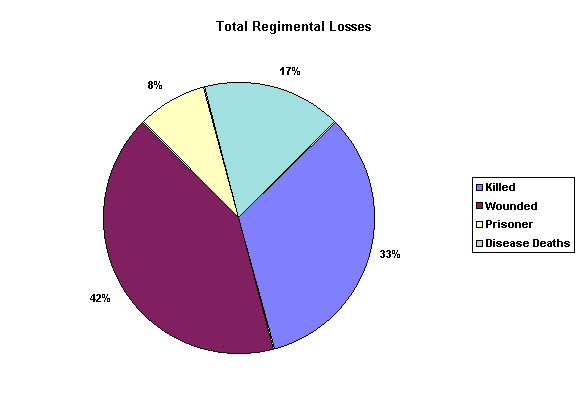
|
|
Killed |
Wounded |
Prisoner |
Disease Deaths |
|
Officers |
1 |
5 |
0 |
0 |
|
Men |
20 |
60 |
8 |
11 |
|
Total |
21 |
65 |
8 |
11 |
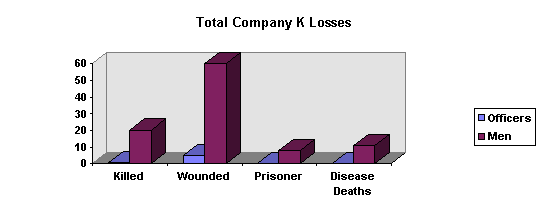
5. Organizational Commanders. The succession of commanders (other than replacements for illness of leave of absence) for II Corps, I Division, and I Brigade follow:
|
II Corps |
I Division |
I Brigade |
|
Edwin V. Sumner |
Israel B. Richardson |
Silas Casey |
|
Darius N. Couch |
Winfield S. Hancock |
Oliver O. Howard |
|
Winfield S. Hancock |
John C. Caldwell |
John C. Caldwell |
|
Andrew A. Humphreys |
Francis C. Barlow |
Edward E. Cross |
|
|
Nelson A. Miles |
Nelson A. Miles |
|
|
|
George W. Scott |
|
|
|
John Fraser |
6. Regimental Commanders. The succession of commanders (other than replacements for illness or leave of absense) for the regiment follow:
Colonel James Miller 08/08/61 to 06/01/62 Death
Colonel Charles F. Johnson 06/01/62 to 07/01/62 Wounded / Transferred
Colonel H. Boyd McKeen 07/01/62 to 05/18/64 Transferred
Colonel William Wilson 05/18/64 to 06/29/65 Mustered Out
7. Company K Commanders. The succession of commanders (other than replacements for illness or leave of absence) for Company K follow:
Capt. Charles E. Foster 08/24/61 to 07/09/62 Resigned
Capt. Cyrus W. Straw 07/09/62 to 06/20/63 Discharged
1st Lt. Alonzo E. Bennett 07/13/63 to 10/12/63 Transferred
Capt. James McKinley 10/12/63 to 06/04/65 Resigned
1st Lt. John Graham 06/16/65 to 06/29/65 Mustered Out
8. Hancock’s Division. According to Fox’s Regimental Losses in the Civil War:
"But the hardest fighting and greatest loss of life occurred in the First Division of the Second Corps, Hancock’s old division, in which more men were killed and wounded than in any other division in the entire Union army, east or west. Its losses aggregated 2,287 killed, 11,724 wounded, and 4,833 missing; total, 18,844. This division was the one which Richardson, its first commander, led on the Peninsula, and at whose head he fell at Antietam; the one which, under Hancock, made the bloody assault on Marye’s Heights; which, under Caldwell, fought so well in the Gettysburg Wheatfield; which, under Barlow, surged over the enemy’s works at Spotsylvania; and which, under Miles, was in at the death in 1865. Within its ranks were the Irish Brigade, and crack regiments like the Fifth New Hampshire, the 140th Pennsylvania, and the 64th New York. Over 14,000 men were killed or wounded in this division during the war; yet it never numbered 8,000 muskets, and often could muster only half that. After the charge on Marye’s Heights it numbered only 2,800."
9. Officers Killed. According to Fox’s Regimental Losses in the Civil War, the 81st was the second highest in the number of officers killed of the entire Union Army. The 61st PVI has the highest with 19 killed. The 81st PVI is a close second with 18 officers killed in battle.
![]()